CHEVROLET TAHOE 2011 3.G Owner's Guide
Manufacturer: CHEVROLET, Model Year: 2011, Model line: TAHOE, Model: CHEVROLET TAHOE 2011 3.GPages: 98, PDF Size: 1.55 MB
Page 31 of 98
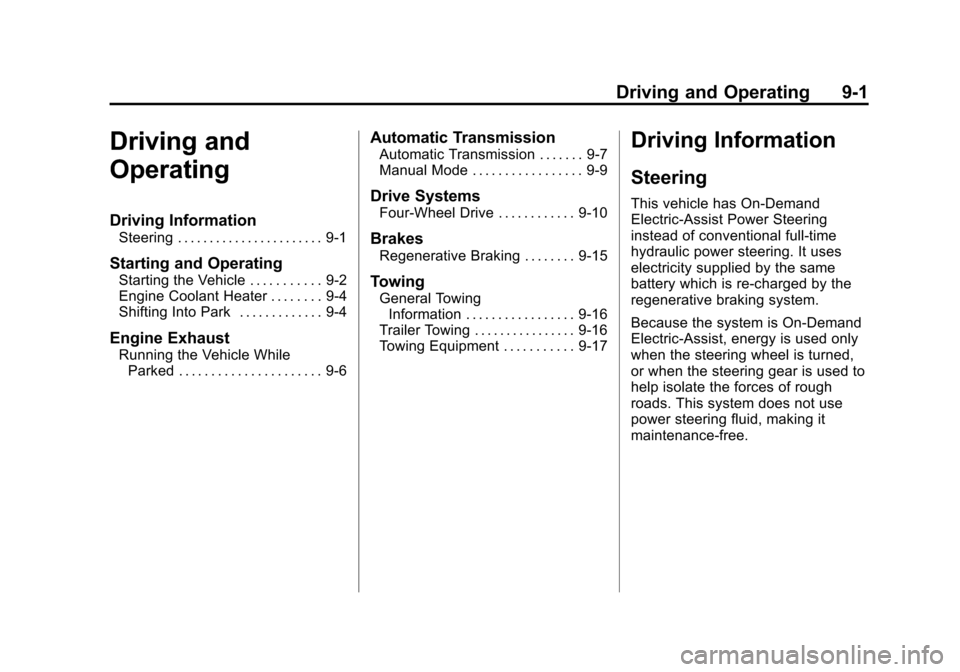
Black plate (1,1)Chevrolet Tahoe and GMC Yukon/Yukon Denali Hybrid - 2011
Driving and Operating 9-1
Driving and
Operating
Driving Information
Steering . . . . . . . . . . . . . . . . . . . . . . . 9-1
Starting and Operating
Starting the Vehicle . . . . . . . . . . . 9-2
Engine Coolant Heater . . . . . . . . 9-4
Shifting Into Park . . . . . . . . . . . . . 9-4
Engine Exhaust
Running the Vehicle WhileParked . . . . . . . . . . . . . . . . . . . . . . 9-6
Automatic Transmission
Automatic Transmission . . . . . . . 9-7
Manual Mode . . . . . . . . . . . . . . . . . 9-9
Drive Systems
Four-Wheel Drive . . . . . . . . . . . . 9-10
Brakes
Regenerative Braking . . . . . . . . 9-15
Towing
General TowingInformation . . . . . . . . . . . . . . . . . 9-16
Trailer Towing . . . . . . . . . . . . . . . . 9-16
Towing Equipment . . . . . . . . . . . 9-17
Driving Information
Steering
This vehicle has On-Demand
Electric-Assist Power Steering
instead of conventional full-time
hydraulic power steering. It uses
electricity supplied by the same
battery which is re-charged by the
regenerative braking system.
Because the system is On-Demand
Electric-Assist, energy is used only
when the steering wheel is turned,
or when the steering gear is used to
help isolate the forces of rough
roads. This system does not use
power steering fluid, making it
maintenance-free.
Page 32 of 98
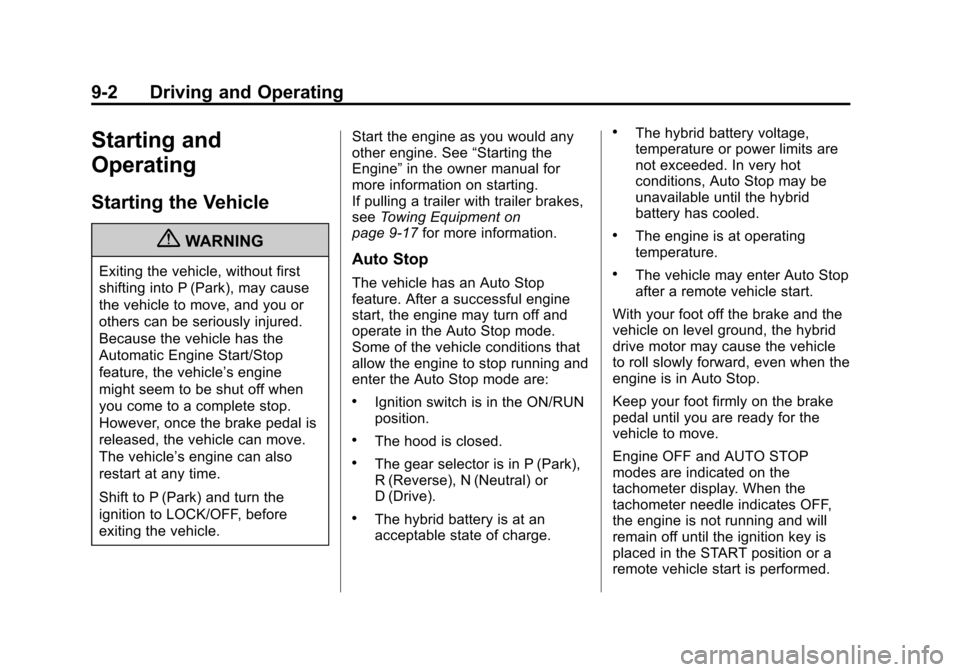
Black plate (2,1)Chevrolet Tahoe and GMC Yukon/Yukon Denali Hybrid - 2011
9-2 Driving and Operating
Starting and
Operating
Starting the Vehicle
{WARNING
Exiting the vehicle, without first
shifting into P (Park), may cause
the vehicle to move, and you or
others can be seriously injured.
Because the vehicle has the
Automatic Engine Start/Stop
feature, the vehicle’s engine
might seem to be shut off when
you come to a complete stop.
However, once the brake pedal is
released, the vehicle can move.
The vehicle’s engine can also
restart at any time.
Shift to P (Park) and turn the
ignition to LOCK/OFF, before
exiting the vehicle.Start the engine as you would any
other engine. See
“Starting the
Engine” in the owner manual for
more information on starting.
If pulling a trailer with trailer brakes,
see Towing Equipment on
page 9‑17 for more information.Auto Stop
The vehicle has an Auto Stop
feature. After a successful engine
start, the engine may turn off and
operate in the Auto Stop mode.
Some of the vehicle conditions that
allow the engine to stop running and
enter the Auto Stop mode are:
.Ignition switch is in the ON/RUN
position.
.The hood is closed.
.The gear selector is in P (Park),
R (Reverse), N (Neutral) or
D (Drive).
.The hybrid battery is at an
acceptable state of charge.
.The hybrid battery voltage,
temperature or power limits are
not exceeded. In very hot
conditions, Auto Stop may be
unavailable until the hybrid
battery has cooled.
.The engine is at operating
temperature.
.The vehicle may enter Auto Stop
after a remote vehicle start.
With your foot off the brake and the
vehicle on level ground, the hybrid
drive motor may cause the vehicle
to roll slowly forward, even when the
engine is in Auto Stop.
Keep your foot firmly on the brake
pedal until you are ready for the
vehicle to move.
Engine OFF and AUTO STOP
modes are indicated on the
tachometer display. When the
tachometer needle indicates OFF,
the engine is not running and will
remain off until the ignition key is
placed in the START position or a
remote vehicle start is performed.
Page 33 of 98
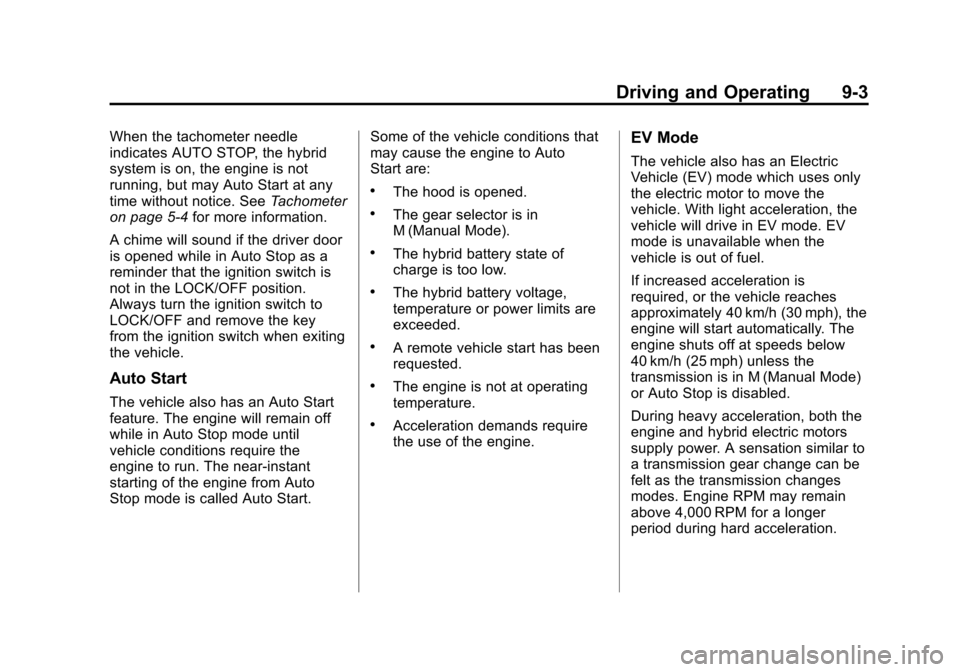
Black plate (3,1)Chevrolet Tahoe and GMC Yukon/Yukon Denali Hybrid - 2011
Driving and Operating 9-3
When the tachometer needle
indicates AUTO STOP, the hybrid
system is on, the engine is not
running, but may Auto Start at any
time without notice. SeeTachometer
on page 5‑4 for more information.
A chime will sound if the driver door
is opened while in Auto Stop as a
reminder that the ignition switch is
not in the LOCK/OFF position.
Always turn the ignition switch to
LOCK/OFF and remove the key
from the ignition switch when exiting
the vehicle.
Auto Start
The vehicle also has an Auto Start
feature. The engine will remain off
while in Auto Stop mode until
vehicle conditions require the
engine to run. The near-instant
starting of the engine from Auto
Stop mode is called Auto Start. Some of the vehicle conditions that
may cause the engine to Auto
Start are:
.The hood is opened.
.The gear selector is in
M (Manual Mode).
.The hybrid battery state of
charge is too low.
.The hybrid battery voltage,
temperature or power limits are
exceeded.
.A remote vehicle start has been
requested.
.The engine is not at operating
temperature.
.Acceleration demands require
the use of the engine.
EV Mode
The vehicle also has an Electric
Vehicle (EV) mode which uses only
the electric motor to move the
vehicle. With light acceleration, the
vehicle will drive in EV mode. EV
mode is unavailable when the
vehicle is out of fuel.
If increased acceleration is
required, or the vehicle reaches
approximately 40 km/h (30 mph), the
engine will start automatically. The
engine shuts off at speeds below
40 km/h (25 mph) unless the
transmission is in M (Manual Mode)
or Auto Stop is disabled.
During heavy acceleration, both the
engine and hybrid electric motors
supply power. A sensation similar to
a transmission gear change can be
felt as the transmission changes
modes. Engine RPM may remain
above 4,000 RPM for a longer
period during hard acceleration.
Page 34 of 98
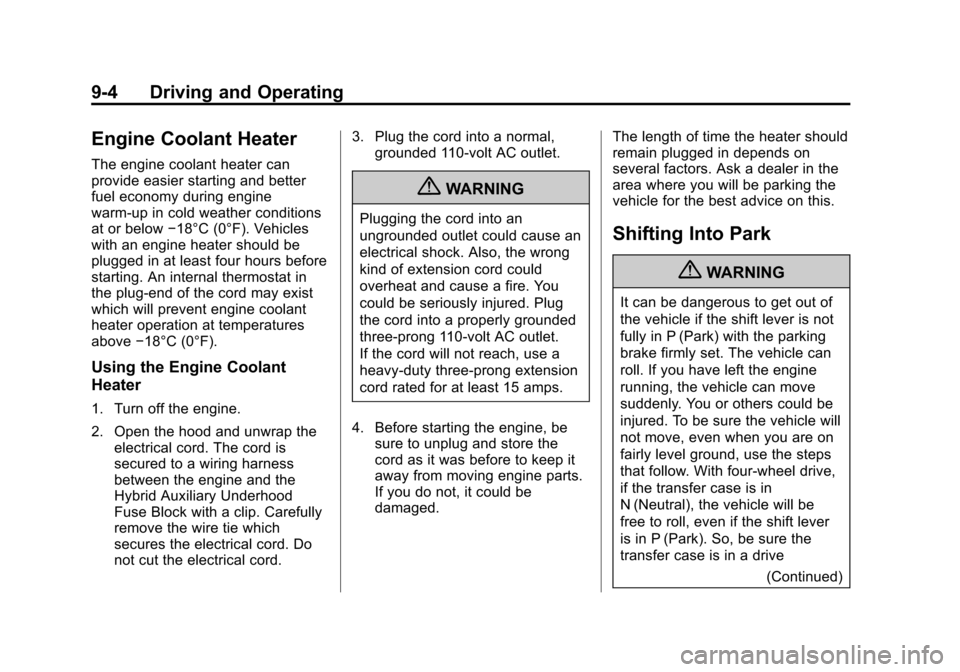
Black plate (4,1)Chevrolet Tahoe and GMC Yukon/Yukon Denali Hybrid - 2011
9-4 Driving and Operating
Engine Coolant Heater
The engine coolant heater can
provide easier starting and better
fuel economy during engine
warm-up in cold weather conditions
at or below−18°C (0°F). Vehicles
with an engine heater should be
plugged in at least four hours before
starting. An internal thermostat in
the plug-end of the cord may exist
which will prevent engine coolant
heater operation at temperatures
above −18°C (0°F).
Using the Engine Coolant
Heater
1. Turn off the engine.
2. Open the hood and unwrap the
electrical cord. The cord is
secured to a wiring harness
between the engine and the
Hybrid Auxiliary Underhood
Fuse Block with a clip. Carefully
remove the wire tie which
secures the electrical cord. Do
not cut the electrical cord. 3. Plug the cord into a normal,
grounded 110-volt AC outlet.
{WARNING
Plugging the cord into an
ungrounded outlet could cause an
electrical shock. Also, the wrong
kind of extension cord could
overheat and cause a fire. You
could be seriously injured. Plug
the cord into a properly grounded
three-prong 110-volt AC outlet.
If the cord will not reach, use a
heavy-duty three-prong extension
cord rated for at least 15 amps.
4. Before starting the engine, be sure to unplug and store the
cord as it was before to keep it
away from moving engine parts.
If you do not, it could be
damaged. The length of time the heater should
remain plugged in depends on
several factors. Ask a dealer in the
area where you will be parking the
vehicle for the best advice on this.
Shifting Into Park
{WARNING
It can be dangerous to get out of
the vehicle if the shift lever is not
fully in P (Park) with the parking
brake firmly set. The vehicle can
roll. If you have left the engine
running, the vehicle can move
suddenly. You or others could be
injured. To be sure the vehicle will
not move, even when you are on
fairly level ground, use the steps
that follow. With four-wheel drive,
if the transfer case is in
N (Neutral), the vehicle will be
free to roll, even if the shift lever
is in P (Park). So, be sure the
transfer case is in a drive
(Continued)
Page 35 of 98
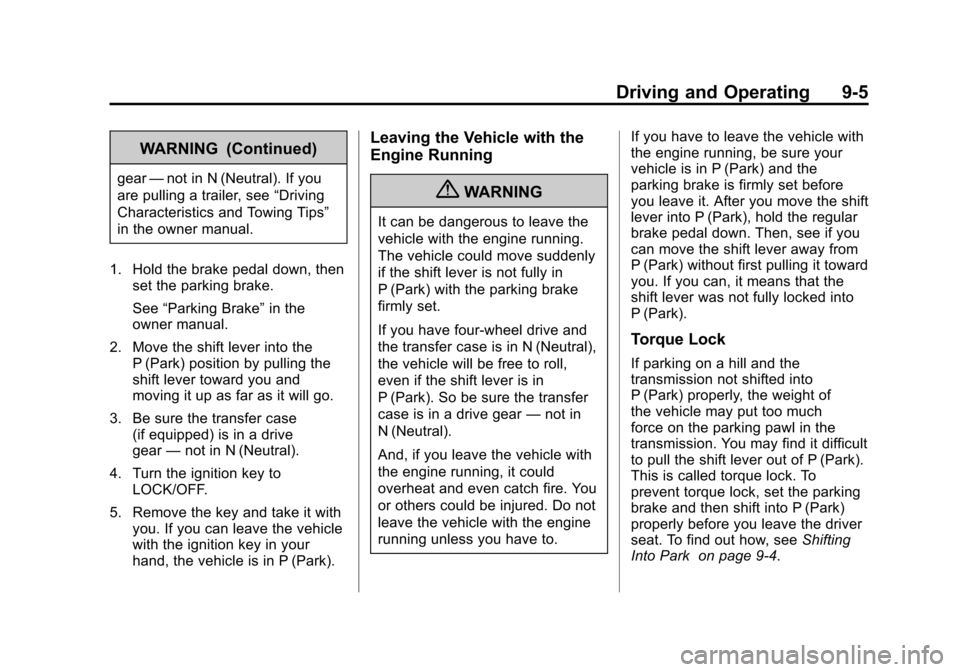
Black plate (5,1)Chevrolet Tahoe and GMC Yukon/Yukon Denali Hybrid - 2011
Driving and Operating 9-5
WARNING (Continued)
gear—not in N (Neutral). If you
are pulling a trailer, see “Driving
Characteristics and Towing Tips”
in the owner manual.
1. Hold the brake pedal down, then set the parking brake.
See “Parking Brake” in the
owner manual.
2. Move the shift lever into the P (Park) position by pulling the
shift lever toward you and
moving it up as far as it will go.
3. Be sure the transfer case (if equipped) is in a drive
gear —not in N (Neutral).
4. Turn the ignition key to LOCK/OFF.
5. Remove the key and take it with you. If you can leave the vehicle
with the ignition key in your
hand, the vehicle is in P (Park).
Leaving the Vehicle with the
Engine Running
{WARNING
It can be dangerous to leave the
vehicle with the engine running.
The vehicle could move suddenly
if the shift lever is not fully in
P (Park) with the parking brake
firmly set.
If you have four-wheel drive and
the transfer case is in N (Neutral),
the vehicle will be free to roll,
even if the shift lever is in
P (Park). So be sure the transfer
case is in a drive gear —not in
N (Neutral).
And, if you leave the vehicle with
the engine running, it could
overheat and even catch fire. You
or others could be injured. Do not
leave the vehicle with the engine
running unless you have to. If you have to leave the vehicle with
the engine running, be sure your
vehicle is in P (Park) and the
parking brake is firmly set before
you leave it. After you move the shift
lever into P (Park), hold the regular
brake pedal down. Then, see if you
can move the shift lever away from
P (Park) without first pulling it toward
you. If you can, it means that the
shift lever was not fully locked into
P (Park).
Torque Lock
If parking on a hill and the
transmission not shifted into
P (Park) properly, the weight of
the vehicle may put too much
force on the parking pawl in the
transmission. You may find it difficult
to pull the shift lever out of P (Park).
This is called torque lock. To
prevent torque lock, set the parking
brake and then shift into P (Park)
properly before you leave the driver
seat. To find out how, see
Shifting
Into Park on page 9‑4.
Page 36 of 98
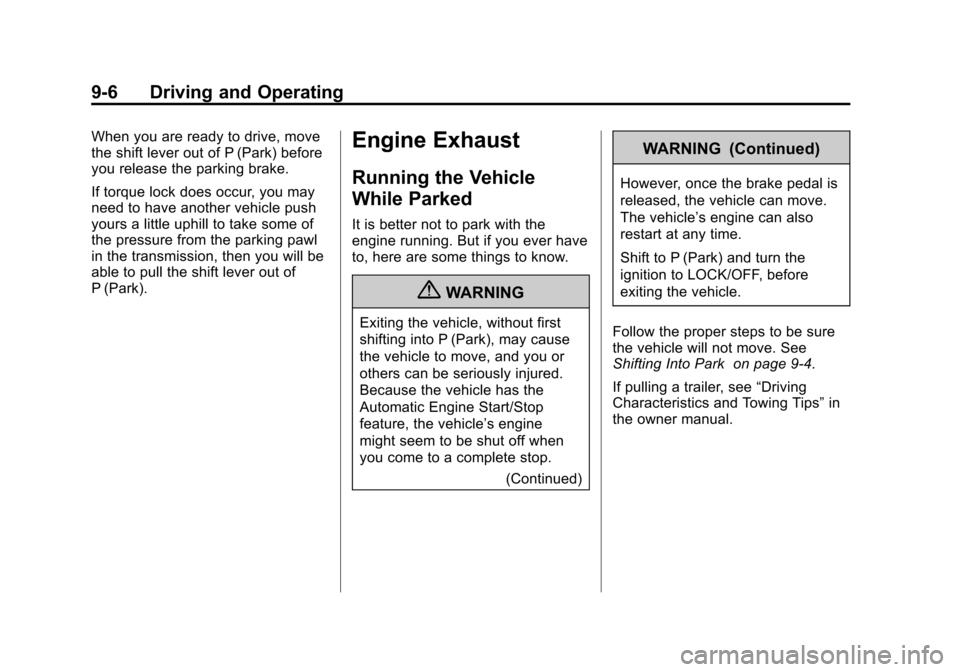
Black plate (6,1)Chevrolet Tahoe and GMC Yukon/Yukon Denali Hybrid - 2011
9-6 Driving and Operating
When you are ready to drive, move
the shift lever out of P (Park) before
you release the parking brake.
If torque lock does occur, you may
need to have another vehicle push
yours a little uphill to take some of
the pressure from the parking pawl
in the transmission, then you will be
able to pull the shift lever out of
P (Park).Engine Exhaust
Running the Vehicle
While Parked
It is better not to park with the
engine running. But if you ever have
to, here are some things to know.
{WARNING
Exiting the vehicle, without first
shifting into P (Park), may cause
the vehicle to move, and you or
others can be seriously injured.
Because the vehicle has the
Automatic Engine Start/Stop
feature, the vehicle’s engine
might seem to be shut off when
you come to a complete stop.(Continued)
WARNING (Continued)
However, once the brake pedal is
released, the vehicle can move.
The vehicle’s engine can also
restart at any time.
Shift to P (Park) and turn the
ignition to LOCK/OFF, before
exiting the vehicle.
Follow the proper steps to be sure
the vehicle will not move. See
Shifting Into Park on page 9‑4.
If pulling a trailer, see “Driving
Characteristics and Towing Tips” in
the owner manual.
Page 37 of 98
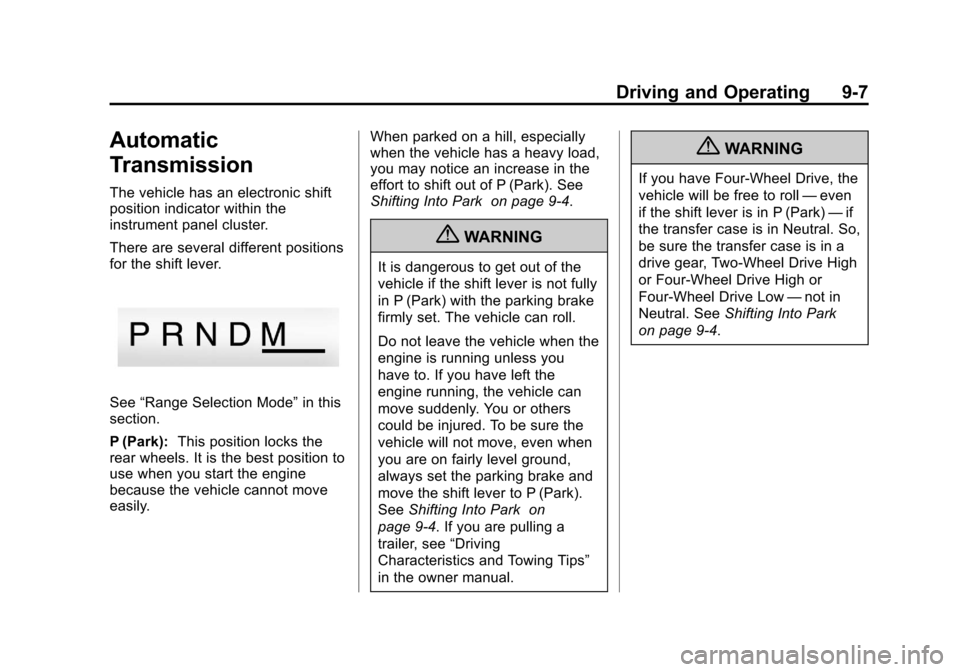
Black plate (7,1)Chevrolet Tahoe and GMC Yukon/Yukon Denali Hybrid - 2011
Driving and Operating 9-7
Automatic
Transmission
The vehicle has an electronic shift
position indicator within the
instrument panel cluster.
There are several different positions
for the shift lever.
See“Range Selection Mode” in this
section.
P (Park): This position locks the
rear wheels. It is the best position to
use when you start the engine
because the vehicle cannot move
easily. When parked on a hill, especially
when the vehicle has a heavy load,
you may notice an increase in the
effort to shift out of P (Park). See
Shifting Into Park on page 9‑4.
{WARNING
It is dangerous to get out of the
vehicle if the shift lever is not fully
in P (Park) with the parking brake
firmly set. The vehicle can roll.
Do not leave the vehicle when the
engine is running unless you
have to. If you have left the
engine running, the vehicle can
move suddenly. You or others
could be injured. To be sure the
vehicle will not move, even when
you are on fairly level ground,
always set the parking brake and
move the shift lever to P (Park).
See
Shifting Into Park on
page 9‑4. If you are pulling a
trailer, see “Driving
Characteristics and Towing Tips”
in the owner manual.
{WARNING
If you have Four-Wheel Drive, the
vehicle will be free to roll —even
if the shift lever is in P (Park) —if
the transfer case is in Neutral. So,
be sure the transfer case is in a
drive gear, Two-Wheel Drive High
or Four-Wheel Drive High or
Four-Wheel Drive Low —not in
Neutral. See Shifting Into Park
on page 9‑4.
Page 38 of 98
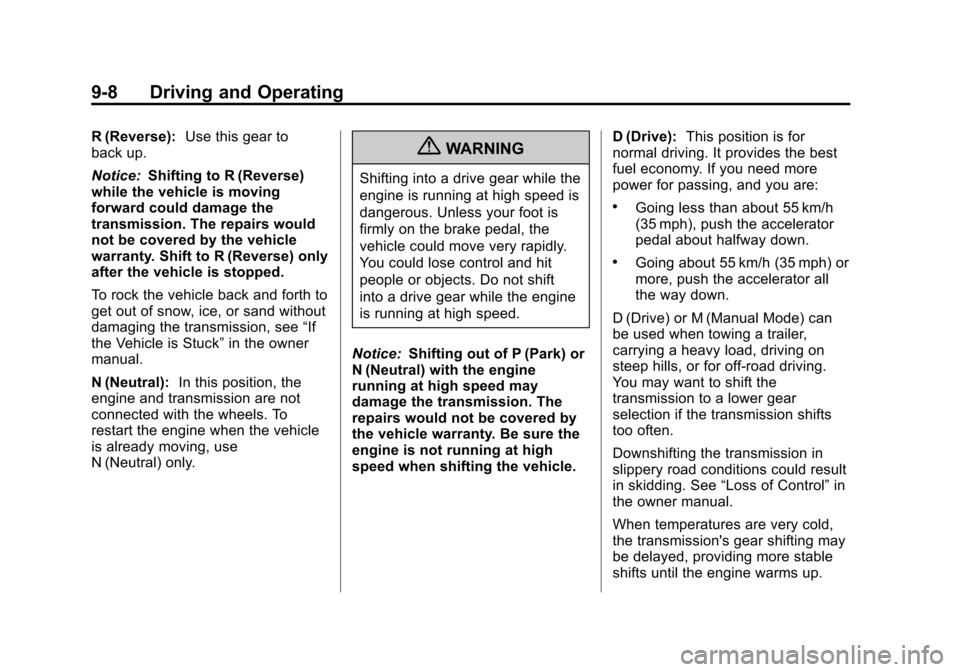
Black plate (8,1)Chevrolet Tahoe and GMC Yukon/Yukon Denali Hybrid - 2011
9-8 Driving and Operating
R (Reverse):Use this gear to
back up.
Notice: Shifting to R (Reverse)
while the vehicle is moving
forward could damage the
transmission. The repairs would
not be covered by the vehicle
warranty. Shift to R (Reverse) only
after the vehicle is stopped.
To rock the vehicle back and forth to
get out of snow, ice, or sand without
damaging the transmission, see “If
the Vehicle is Stuck” in the owner
manual.
N (Neutral): In this position, the
engine and transmission are not
connected with the wheels. To
restart the engine when the vehicle
is already moving, use
N (Neutral) only.{WARNING
Shifting into a drive gear while the
engine is running at high speed is
dangerous. Unless your foot is
firmly on the brake pedal, the
vehicle could move very rapidly.
You could lose control and hit
people or objects. Do not shift
into a drive gear while the engine
is running at high speed.
Notice: Shifting out of P (Park) or
N (Neutral) with the engine
running at high speed may
damage the transmission. The
repairs would not be covered by
the vehicle warranty. Be sure the
engine is not running at high
speed when shifting the vehicle. D (Drive):
This position is for
normal driving. It provides the best
fuel economy. If you need more
power for passing, and you are:
.Going less than about 55 km/h
(35 mph), push the accelerator
pedal about halfway down.
.Going about 55 km/h (35 mph) or
more, push the accelerator all
the way down.
D (Drive) or M (Manual Mode) can
be used when towing a trailer,
carrying a heavy load, driving on
steep hills, or for off-road driving.
You may want to shift the
transmission to a lower gear
selection if the transmission shifts
too often.
Downshifting the transmission in
slippery road conditions could result
in skidding. See “Loss of Control” in
the owner manual.
When temperatures are very cold,
the transmission's gear shifting may
be delayed, providing more stable
shifts until the engine warms up.
Page 39 of 98
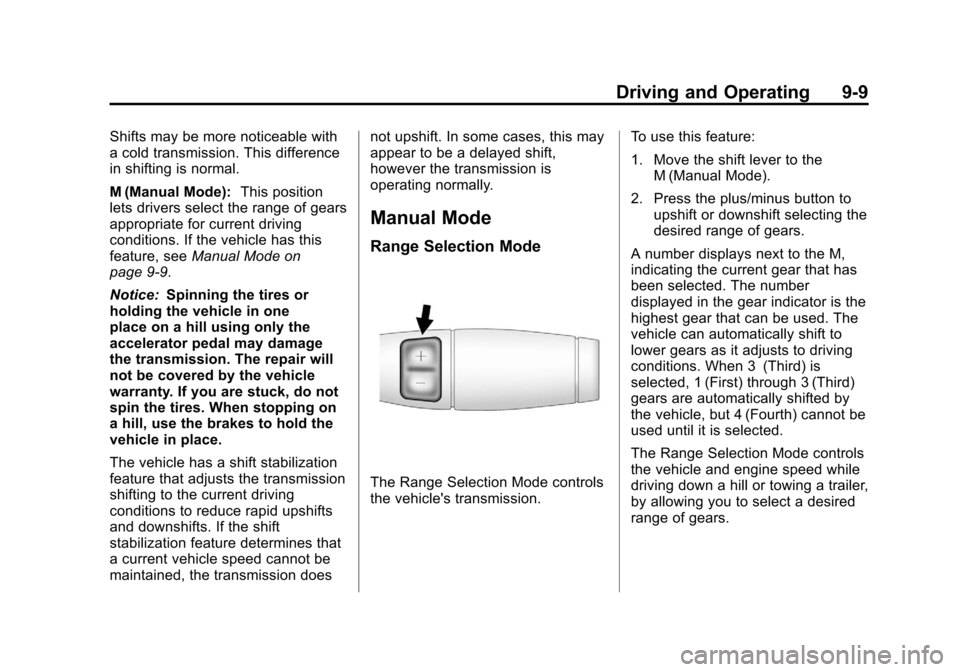
Black plate (9,1)Chevrolet Tahoe and GMC Yukon/Yukon Denali Hybrid - 2011
Driving and Operating 9-9
Shifts may be more noticeable with
a cold transmission. This difference
in shifting is normal.
M (Manual Mode):This position
lets drivers select the range of gears
appropriate for current driving
conditions. If the vehicle has this
feature, see Manual Mode on
page 9‑9.
Notice: Spinning the tires or
holding the vehicle in one
place on a hill using only the
accelerator pedal may damage
the transmission. The repair will
not be covered by the vehicle
warranty. If you are stuck, do not
spin the tires. When stopping on
a hill, use the brakes to hold the
vehicle in place.
The vehicle has a shift stabilization
feature that adjusts the transmission
shifting to the current driving
conditions to reduce rapid upshifts
and downshifts. If the shift
stabilization feature determines that
a current vehicle speed cannot be
maintained, the transmission does not upshift. In some cases, this may
appear to be a delayed shift,
however the transmission is
operating normally.
Manual Mode
Range Selection Mode
The Range Selection Mode controls
the vehicle's transmission.
To use this feature:
1. Move the shift lever to the
M (Manual Mode).
2. Press the plus/minus button to upshift or downshift selecting the
desired range of gears.
A number displays next to the M,
indicating the current gear that has
been selected. The number
displayed in the gear indicator is the
highest gear that can be used. The
vehicle can automatically shift to
lower gears as it adjusts to driving
conditions. When 3 (Third) is
selected, 1 (First) through 3 (Third)
gears are automatically shifted by
the vehicle, but 4 (Fourth) cannot be
used until it is selected.
The Range Selection Mode controls
the vehicle and engine speed while
driving down a hill or towing a trailer,
by allowing you to select a desired
range of gears.
Page 40 of 98
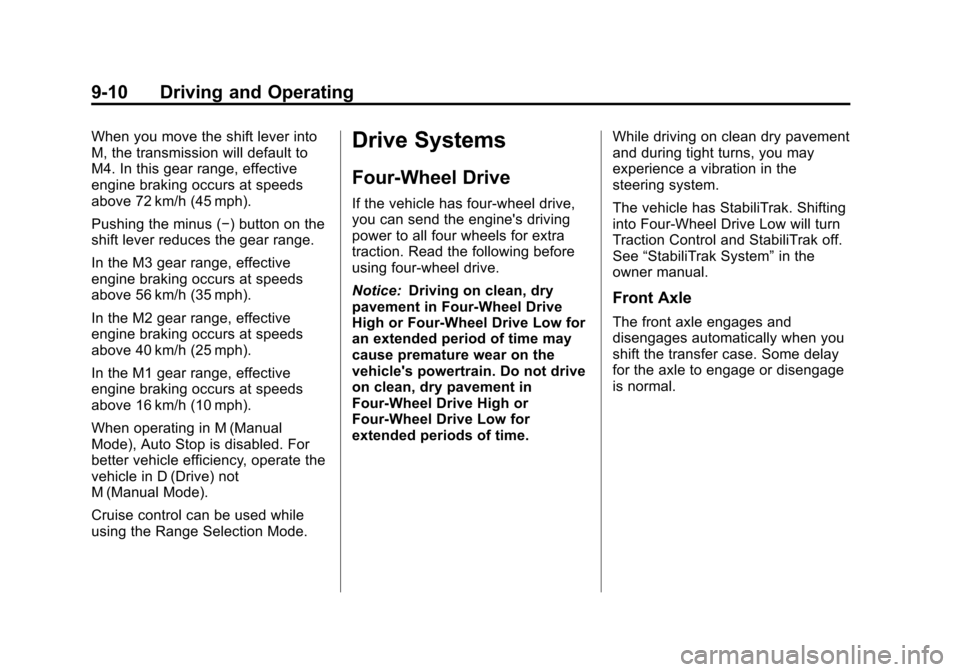
Black plate (10,1)Chevrolet Tahoe and GMC Yukon/Yukon Denali Hybrid - 2011
9-10 Driving and Operating
When you move the shift lever into
M, the transmission will default to
M4. In this gear range, effective
engine braking occurs at speeds
above 72 km/h (45 mph).
Pushing the minus (−) button on the
shift lever reduces the gear range.
In the M3 gear range, effective
engine braking occurs at speeds
above 56 km/h (35 mph).
In the M2 gear range, effective
engine braking occurs at speeds
above 40 km/h (25 mph).
In the M1 gear range, effective
engine braking occurs at speeds
above 16 km/h (10 mph).
When operating in M (Manual
Mode), Auto Stop is disabled. For
better vehicle efficiency, operate the
vehicle in D (Drive) not
M (Manual Mode).
Cruise control can be used while
using the Range Selection Mode.Drive Systems
Four-Wheel Drive
If the vehicle has four-wheel drive,
you can send the engine's driving
power to all four wheels for extra
traction. Read the following before
using four-wheel drive.
Notice:Driving on clean, dry
pavement in Four-Wheel Drive
High or Four-Wheel Drive Low for
an extended period of time may
cause premature wear on the
vehicle's powertrain. Do not drive
on clean, dry pavement in
Four-Wheel Drive High or
Four-Wheel Drive Low for
extended periods of time. While driving on clean dry pavement
and during tight turns, you may
experience a vibration in the
steering system.
The vehicle has StabiliTrak. Shifting
into Four-Wheel Drive Low will turn
Traction Control and StabiliTrak off.
See
“StabiliTrak System” in the
owner manual.
Front Axle
The front axle engages and
disengages automatically when you
shift the transfer case. Some delay
for the axle to engage or disengage
is normal.